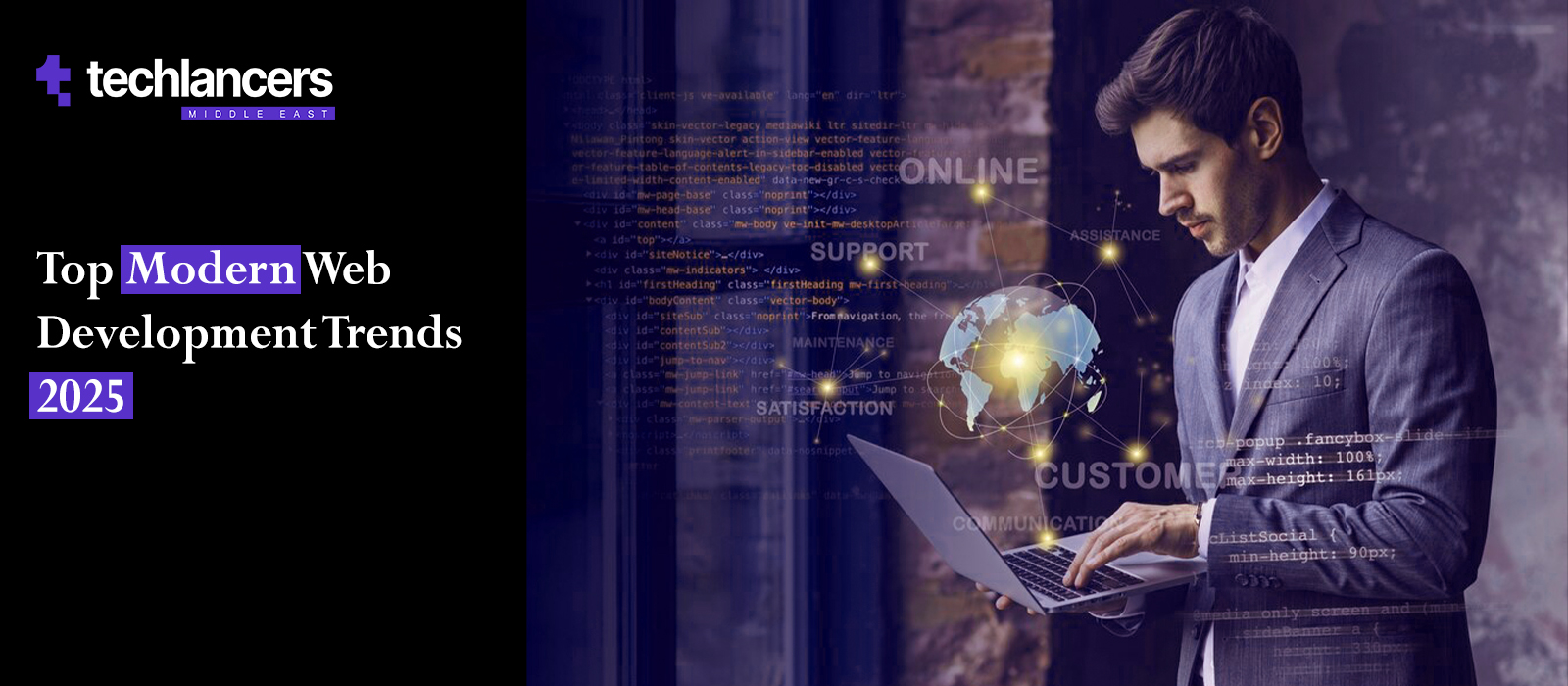Top Modern Web Development Trends 2025

Website design and development is an ever-evolving field that requires constant improvements and adjustments to the latest technology. Any online business that doesn’t implement the latest tech trends to their website is missing out on improving user experience and sale conversions. Over the years, website development has gone through dramatic changes and every year new technologies pave the way for improvement in site structure, user experience, and consumer behavior online. Staying up to date with the top web development technologies of 2025 will help your online business stay relevant in the market.
7 Modern Web Development Trends Likely to Continue in 2025
Several emerging web development trends are to shape the upcoming future of website and web app development. Some of these trends have already made their ground in 2024 and will most likely become more popular in 2025.
Ai in Web Development
There’s no denying that AI has taken over several job roles – consistently assisting marketing and developers. It’s expected by 2025, AI will help developers automate tasks like code generation, testing, and bug fixes. In addition, AI is expected to analyze consumer behavior on websites and automatically optimize website content to fit each customer segment’s needs. This development isn’t too far because AI-powered chatbots have already helped developers in code generation and customer engagement on websites.
Voice Search Optimization
Voice search has been around since 2023 and it’s slowly picking up pace. According to DemandSage, voice search’s market share has been improving year over year. Sites that aren’t optimized for voice search in 2025 are going to take a massive hit. That’s because voice search has been a prevalent website development trend and it’s growing. Tapping into this market as an early entrant ensures your site’s ranking on voice search.
Progressive Web App Development
Progressive web apps are web applications that work and feel like native apps. They can be accessed offline and load quickly – all without the need to download and consume mobile storage. The ease of access and usability of PWA (Progressive Web Apps) make them an ideal substitute for conventional website development. By 2025, we anticipate more companies will move towards PWAs and improve their user experience.
Augmented Reality and Virtual Reality
Augmented reality is shaping the ecommerce industry with visuals that speak volume. By integrating augmented reality features into your ecommerce app, you can take your web development up a notch with creative outcomes. Customers can easily see how their products look at their home before making a purchase. This instigates higher purchases allowing consumers to pick a product that fits their requirements all the while reducing product return cost.
No-Code Development
No code platforms like Wix, Squarespace and WordPress have been in the market for too long and they aren’t going anywhere. This software makes web development easier and more structured. While custom development might require constant site fixes and mobile adjustments, no code platforms have pre-built margin settings that integrate seamlessly with your website design. Existing templates make work a lot easier for businesses as they don’t need to wait months to get their custom website done and ready. No-code website themes are great for launching MVP. Once there’s sufficient consumer data, businesses seamlessly transition to custom development with a tried and tested website design.
The Growth of Serverless Computing
Serverless computing eliminates the need for developers to manage infrastructure, allowing them to focus purely on writing and deploying code. The key benefits include:
- Auto-scaling: Resources scale automatically based on demand, ensuring high availability without unnecessary costs.
- Reduced Operational Costs: Businesses only pay for the actual computing time used, avoiding expenses related to idle servers.
- Faster Development & Deployment: No need for infrastructure setup—developers can quickly build, test, and deploy applications.
Cyber Security First Development
With rising cases of data theft, corporate giants are leaning towards cyber-security first website development. By minimising design elements and development codes, businesses are transitioning to safer web development. Expecting biometric authentication, AI-driven threat detection, and Zero Trust architecture in 2025 modern website design trends will be no surprise. Enterprise level organisation are taking their security seriously and if you haven’t advanced your system, you’ll be left behind.
Wrapping it Up
As we move into 2025, the web development landscape continues to evolve, bringing in cutting-edge technologies that enhance user experience, security, and functionality. Trends like AI-driven automation, voice search optimization, progressive web apps, augmented reality, and serverless computing are no longer futuristic concepts but necessary advancements for any business looking to stay competitive in the digital space.
With no-code development streamlining website creation and cybersecurity-first strategies becoming essential, businesses must adapt to these innovations to ensure efficiency, engagement, and security. The companies that embrace these trends will position themselves ahead of the competition, delivering seamless, high-performing web experiences that meet the evolving needs of modern users.
Whether you’re building a new website or upgrading an existing one, keeping up with these web development trends in 2025 is not just an option—it’s a necessity for digital success. At Techlancers, we drive modern website development with cyber security in-check. Without degrading your website features, we ensure your site is safe from all threats including AI attack drones and manual hacking attempts.

-
Posted By – Saba Sohail
Saba Sohail is a business analyst for client-side software solutions. She has extensive expereince in mobile app development strategy, technology stack, software development cost optimization, cloud computing, product scaling and SaaS monetization.

 Consulting
Consulting Development
Development Growth
Growth

